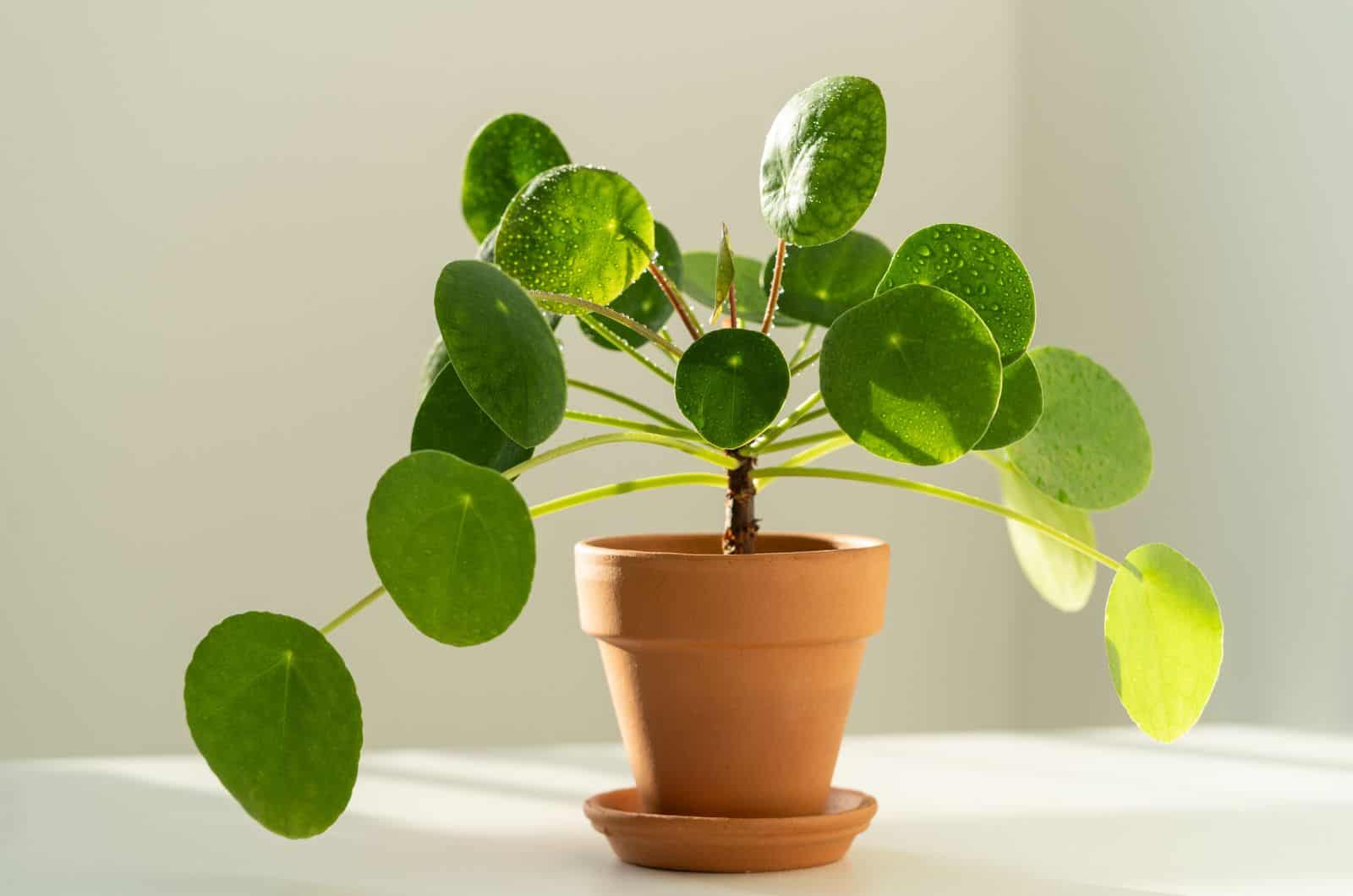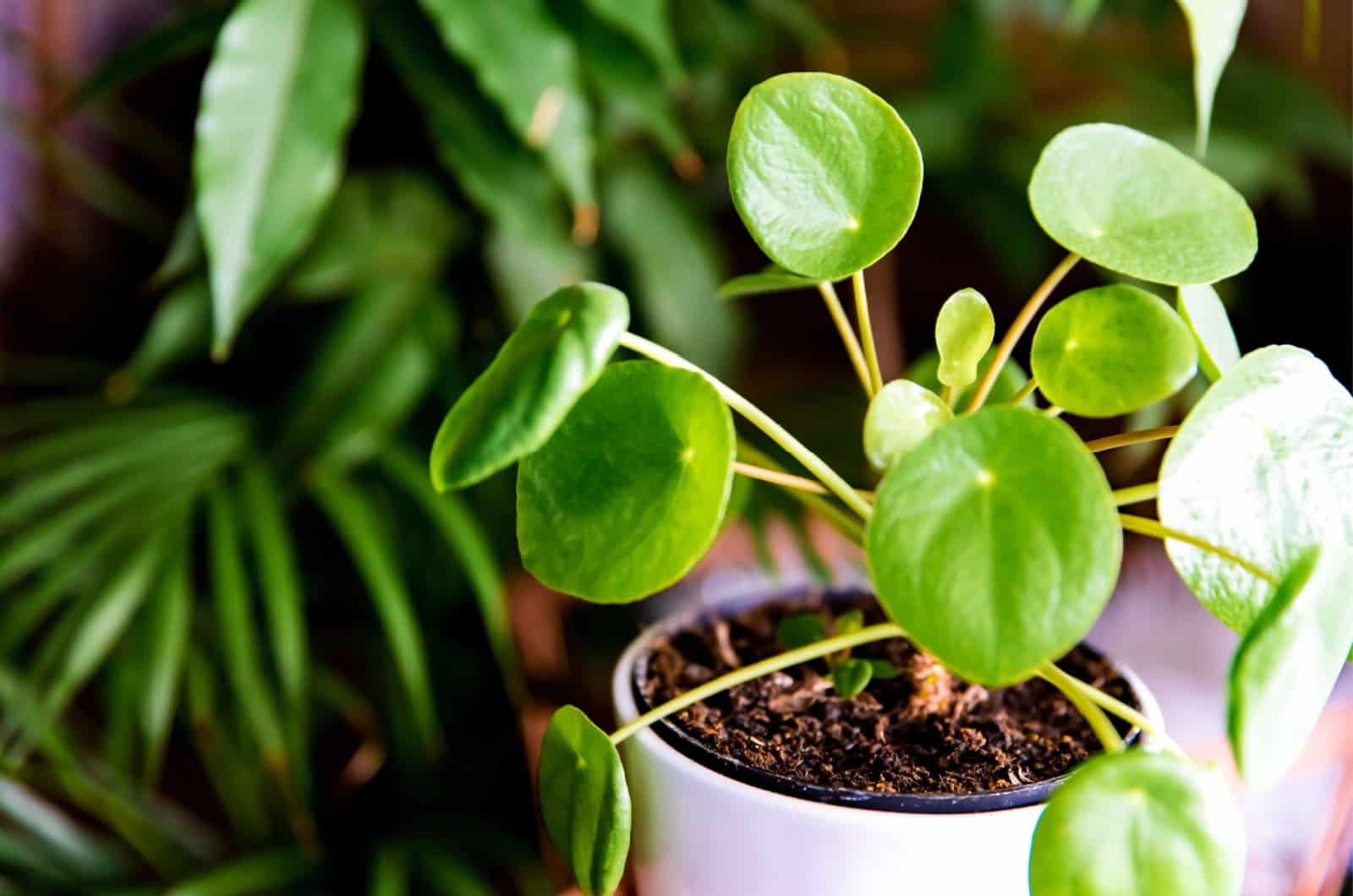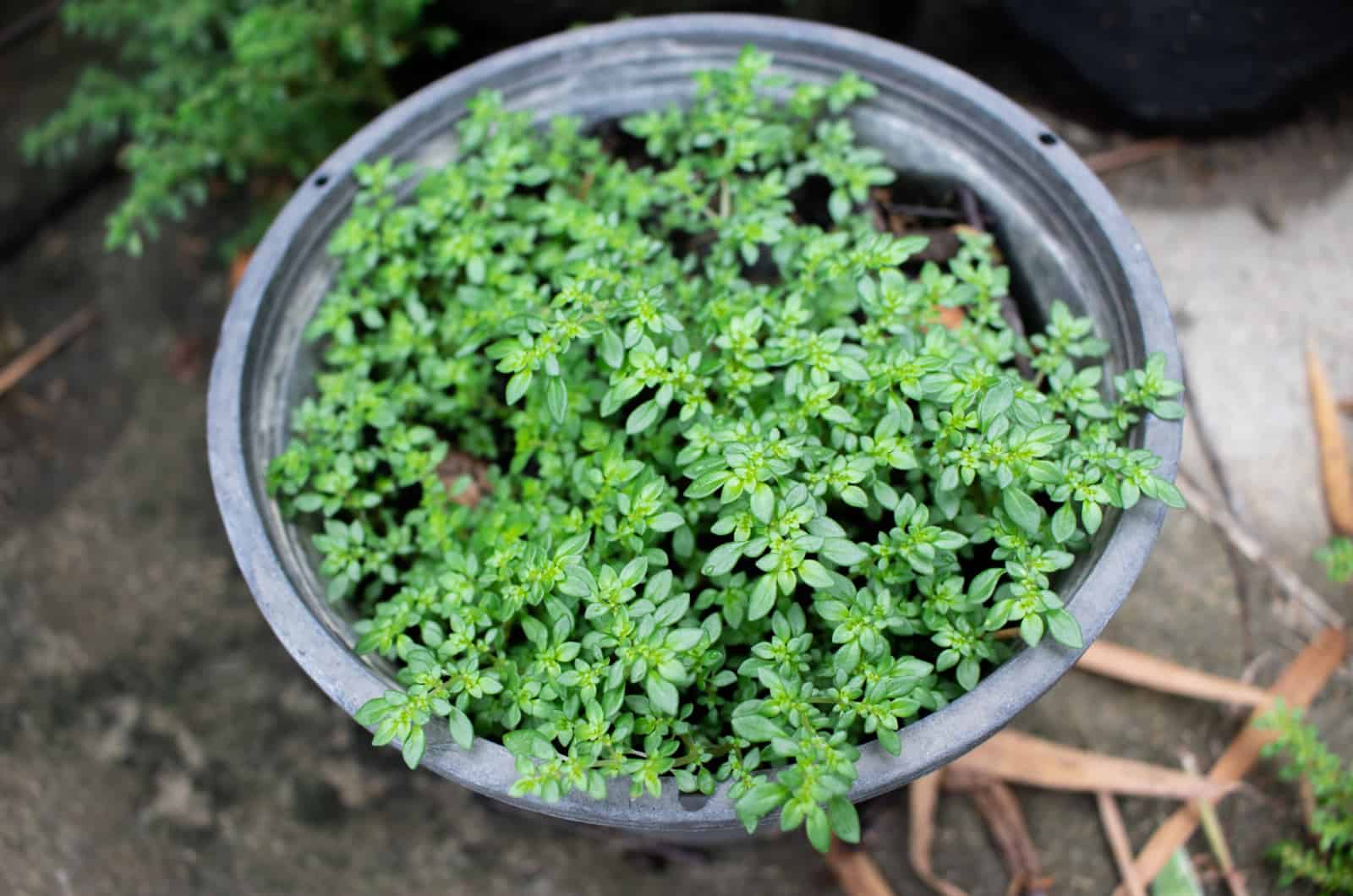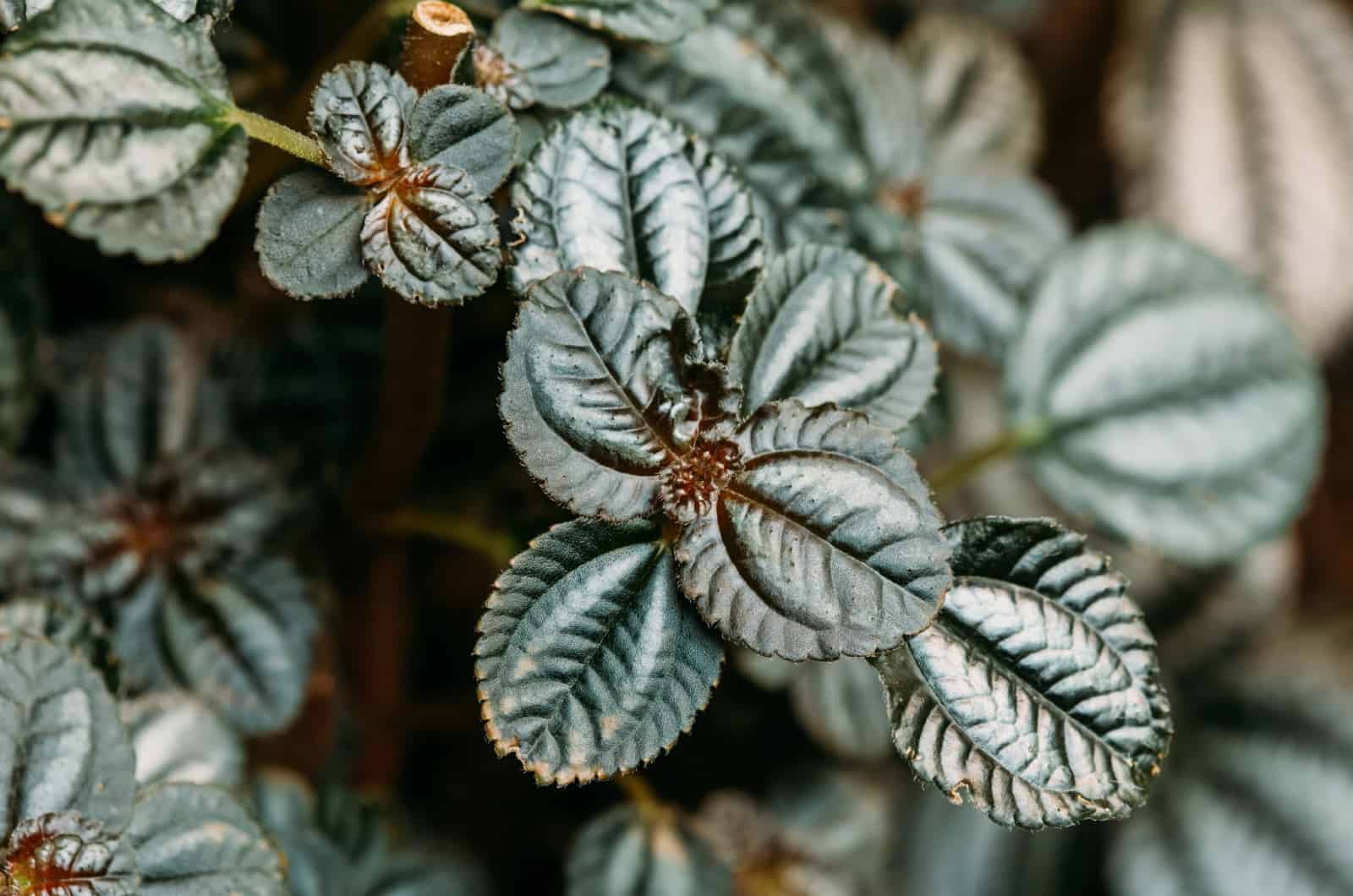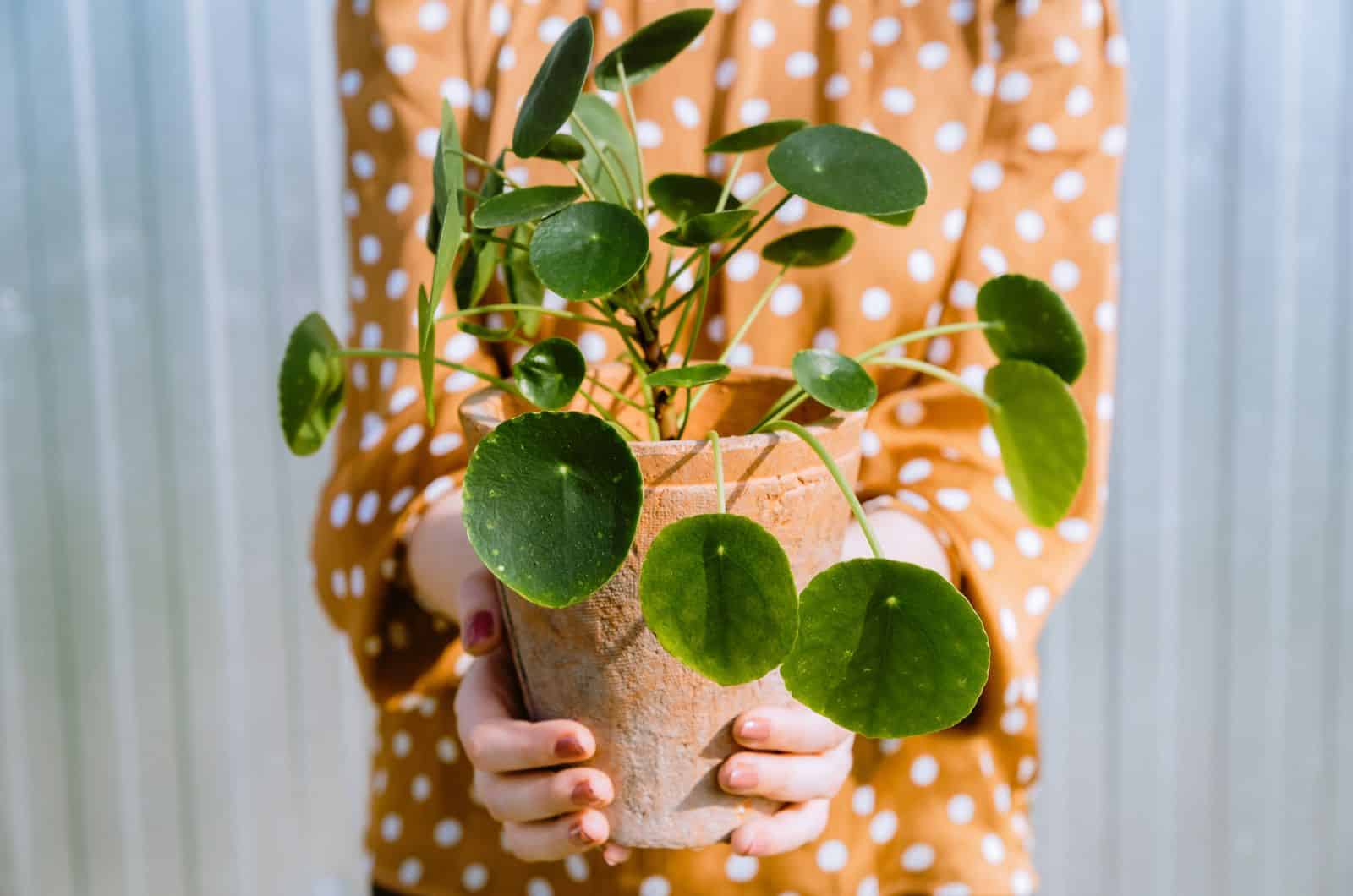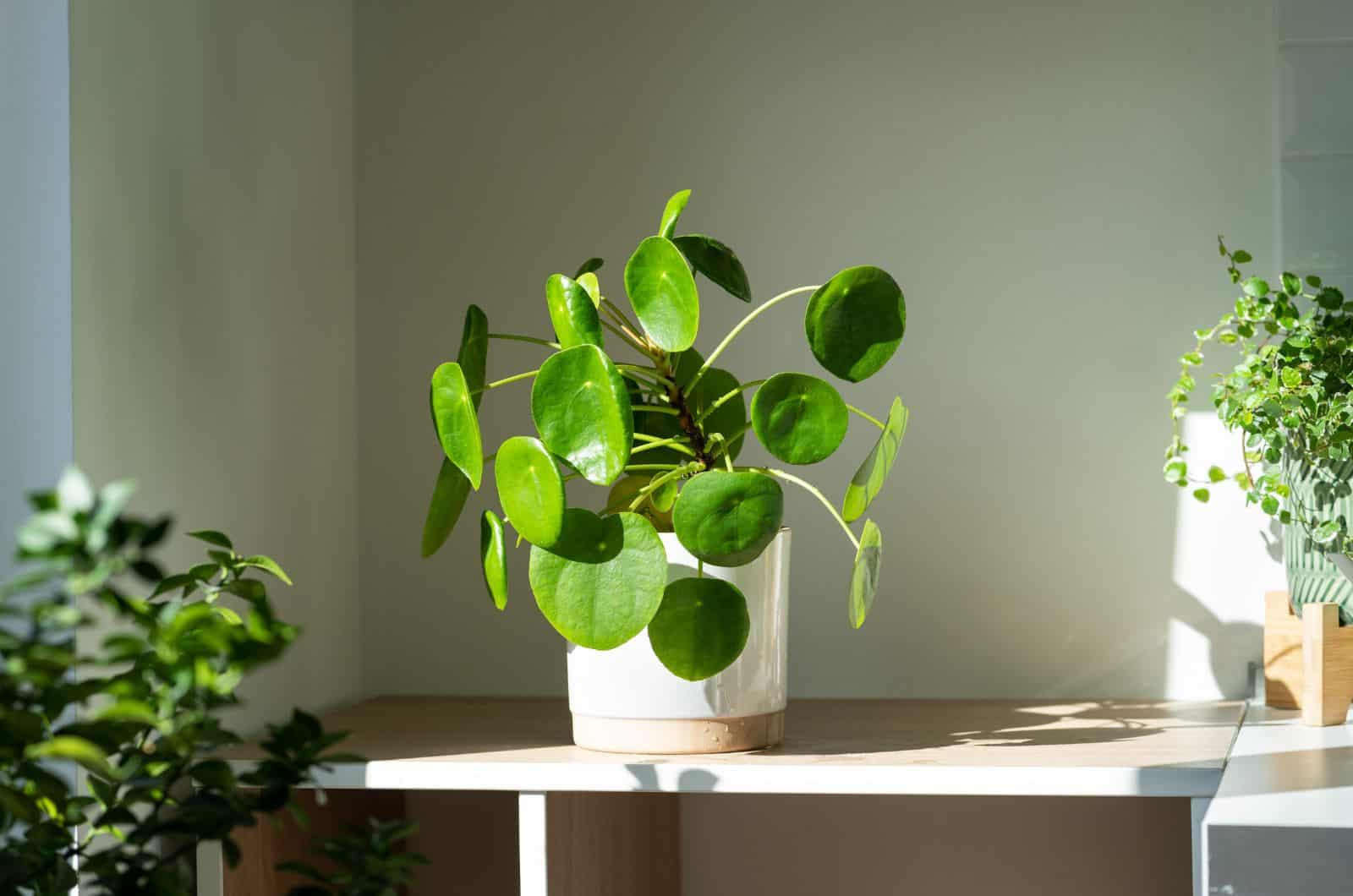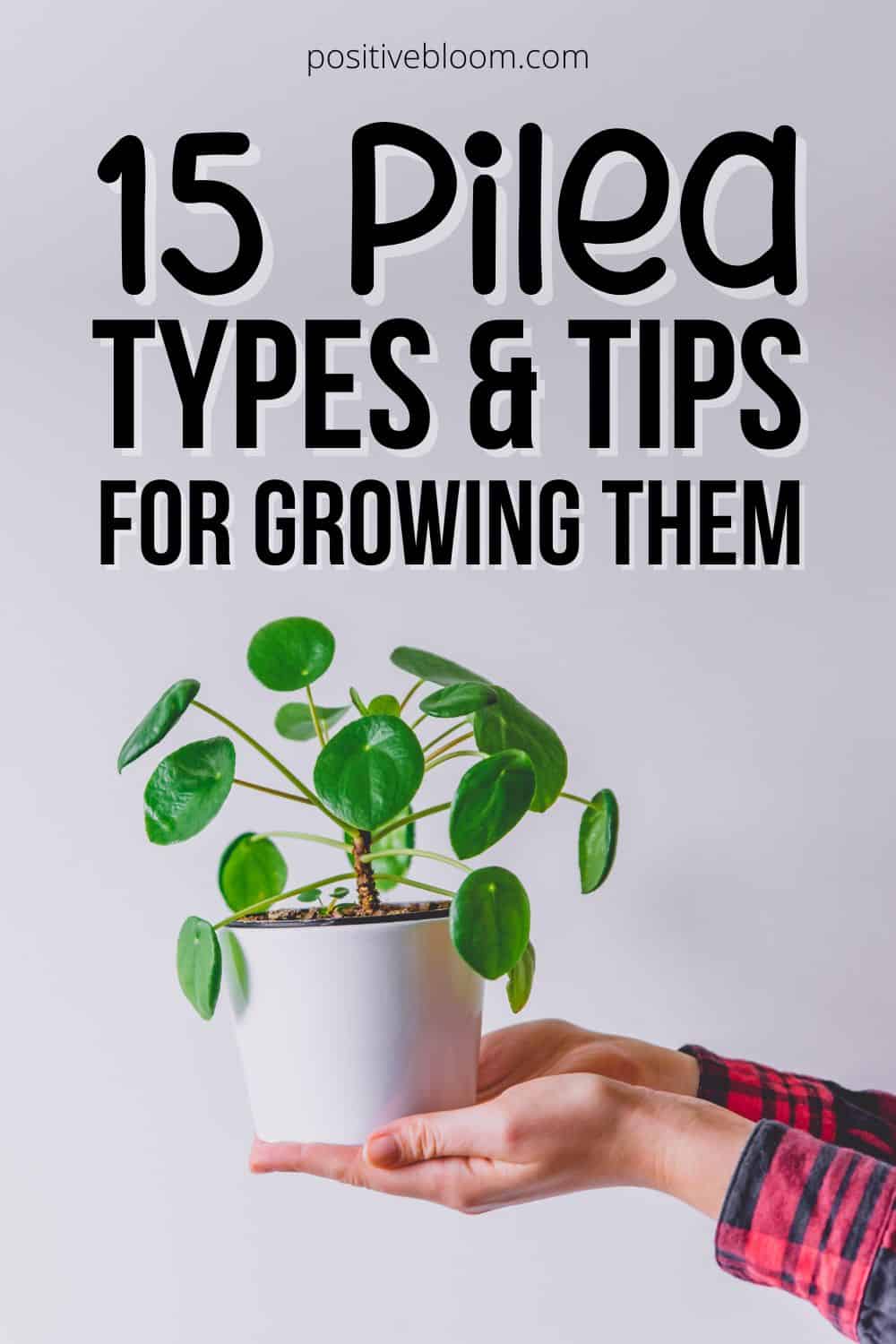There are many Pilea types, so there’s definitely something for everyone. If you need a plant for a hanging basket, terrarium, or coffee table, look no further than a Pilea variety!
These are one of my favorite indoor plants due to their variegated, burgundy, and green leaves!
These plants are perfect for beginner growers due to their low maintenance, so you don’t have to spend too much time tending to their needs.
We’ll still give you a care guide with all their basic requirements, including lighting, watering, fertilizing, and their preferred soil type.
This article also has loads of tips on repotting and propagation, which is great for adding other healthy, fast-growing plants to your indoor garden or even some gifts for someone’s birthday.
So, let’s examine some popular and attractive Pilea types!
15 Pilea Types And Plant Care Guides
Below you will find fifteen Pilea types and some basic info about them, like their botanical names, native habitats, growth rates, etc.
We’ll also discuss some of their most prominent features and look at a basic care guide for each of them.
Let’s begin!
1. Chinese Money Plant
[table id=278 /]Even though the most common name of this variety is the Chinese money plant, Pilea peperomioides is also known as the pancake plant, UFO plant, and coin plant.
Plant Care Overview
The leaves of this plant are green, but if there’s inadequate lighting, watering, or nutrition, you may notice your pilea leaves curling, drooping, and fading in color.
Therefore, you must ensure that it gets enough indirect light, so it doesn’t grow leggy or lose its attractive color. This is one of the most common problems with the Pilea peperomioides plant.
Luckily this plant doesn’t require too much water, but you should still water it once a week during its growing season and every other week during winter or whenever the top few inches of the soil are dry.
The Chinese money plant thrives in moderate temperatures between 60-85°F, and anything lower than 55°F can cause severe damage.
The type of soil you use is very important because heavy mediums can lead to overwatering and root rot. Get some quality potting mix that contains coco coir and peat moss (or make your own if you love working with soil), as these ingredients improve drainage while still allowing some water retention.
Finally, don’t forget about fertilization. Use a general houseplant fertilizer once a month during the growing season.
2. Moon Valley Friendship Plant
[table id=279 /]The mesmerizing green leaves are streaked with brown veins, while the undersides are dark-red, which gives this plant a dramatic effect and makes it a desirable item in any room.
Plant Care Overview
You shouldn’t expose this variety to direct sunlight as it can burn its attractive foliage. Instead, keep it in a bright spot with enough indirect light to prevent legginess and color loss.
You should also water it whenever the topsoil feels dry and ensure that the humidity level is above 50% by either misting or using a humidifier.
This plant prefers to be at room temperature and planted in well-draining soil full of organic content, so you should use African violet potting mix or peat-based substrate.
Finally, you should feed it with a well-balanced fertilizer such as triple 10 once a month during its growing season and always follow the instructions on the packaging.
3. Silver-Leaved Artillery Plant
[table id=280 /]This plant is quite an attraction due to its overall appearance: delicate pink-red stems hold clusters of blue-green leaves that may even appear silver under certain lighting, which is how it has wriggled its way into homes around the world.
Plant Care Overview
This plant can easily get burnt in the direct sun, but you shouldn’t keep it in low-light conditions either because it can lead to legginess, droopiness, loss of color, and many other unsightly issues. However, you can simply expose it to indirect sunlight to see it thrive.
This artillery plant is not greedy for water, but you should still irrigate it once a week when it’s actively growing (or even more frequently if the summers are scorching), and once every other week during dormancy.
It also loves high humidity, so you should find some way of raising it, such as spraying it with water or using a humidifier if you live in an arid climate. Luckily, it thrives at room temperatures, so you can just place it in a bright spot inside your home and adjust the thermometer to suit you and your plant.
4. Aluminum Plant
[table id=281 /]This pilea variety resembles a watermelon, so it’s not surprising that it is also known as the watermelon plant.
It is more compact than the other cultivars of this species, and the silver spots on a bright green background make it irresistible!
Plant Care Overview
Just like all other pilea types, this one also requires bright indirect lighting and irrigation once a week in spring and summer.
However, you might need to water it more often if the temperatures are higher, though you should strive for them to be between 60-85°F to give your plant optimal growing conditions.
There’s been much debate about whether pebble trays work for humidity. Luckily, this plant is rather small, so the water that evaporates from the gravel tray will have no problem reaching the foliage.
Then again, you can always mist your plant or invest in a quality humidifier.
Make sure the growing medium is well-draining by mixing some sand or perlite with peat to get the perfect substrate.
Finally, you should feed this plant once or twice a month with a well-balanced fertilizer – just don’t stray from the recommendations on the back of the packaging.
5. Artillery Plant
Scientific name: Pilea microphylla
[table id=282 /]This pilea is also known as rockweed, angeloweed, joypowder plant, and brilhantina in Latin America.
Its tiny, succulent-like leaves make it an ideal companion for your string of pearls, or they can decorate your home on their own.
Plant Care Overview
This plant thrives in bright indirect light like so many other pilea types, but it can actually tolerate low-light conditions to a degree. However, the full shade will definitely prove detrimental, so avoid keeping it in darkness during the day.
It doesn’t require additional humidity, but it does thrive at moderate relative humidity (around 50%).
Even though it has fleshy leaves, it isn’t really drought-tolerant, so make sure you water it whenever the topsoil dries (which will be more frequent during the summertime).
It prefers fertile, well-draining, loose, and aerated growing mediums, so avoid planting it in heavy clay because it retains too much moisture, which may lead to overwatering and root rot.
Lastly, don’t forget to feed it at least once a month with a houseplant fertilizer diluted to half-strength (or more if indicated on the package).
6. Gray Baby Tears
[table id=283 /]Gray Baby Tears is a variety ideal for ground cover and hanging baskets alike, you just have to decide where you want to grow it.
Its leaves are actually blue-gray, but they can adopt a silverish nuance that only accentuates the attractiveness of the pink-red stems.
There is a variety, Pilea glauca, that belongs to this group and is rather similar to Gray Baby Tears, although some believe that it is actually Pilea glaucophylla due to the similarity of the names.
Plant Care Overview
This variety prefers partial sun and shade, so you should place it near east and south-facing windows. However, it prefers cool winter sun but can tolerate summer sunlight as long as you keep it at least 2 feet away from the window.
You should let the top half of the soil dry out before watering this plant, but don’t let it go too long without water to avoid stressing it out.
Also, because this plant comes from the tropics, you should raise the indoor humidity above 50% with a humidifier, by moving your plant to a more humid place in your home, or simply misting it from time to time.
Gray Baby Tears definitely cannot handle frost, so keep the temperatures somewhere between 70-85°F.
Use a mix of equal parts perlite and peat moss for the best drainage, aeration, and water retention, and don’t forget to fertilize this plant with a general-purpose fertilizer once a month during the growing season.
7. Depressed Clearweed
[table id=284 /]This compact will make your home anything but depressing. It is perfect for small coffee tables and minimalistic designs, and is completely safe for your kids and pets.
Plant Care Overview
The care guide for Pilea depressa is relatively simple: place it in a spot where the direct sun cannot hurt its light green foliage but is bright enough so that it doesn’t suffer from a lack of sunlight.
It doesn’t require too much water, but you still have to water it at least once a week during the time it actively grows (or even more so during hot and dry summers).
It requires high humidity, and anywhere between 60-90% is fine. You can invest in a compact humidifier that will reduce how much you have to mist your plant.
Mix two parts perlite and one part peat moss to create a blend in which this plant can thrive, and fertilize it once a month with a houseplant fertilizer (although it can survive without it if you repot it once a year).
It thrives at room temperature, so don’t let the thermometer go below 60°F.
8. Moon Valley Pilea
[table id=285 /]Even though this cultivar has the same name as the one we already mentioned, the species is different, which is evident by looking at the foliage of this plant.
Even though it is similar to the Pilea involucrata, this Moon Valley has textured, bright yellow-green foliage streaked with copper veins.
Plant Care Overview
You should keep this plant in indirect sunlight and maintain temperatures between 65-75°F for best growth and development.
The more light this plant receives, the more you should water it, which is why you should monitor your plant and irrigate it only when the top couple of inches have dried.
Humidity also needs to be high, so don’t forget to turn on your humidifier when you bring this beauty home!
The soil should be enriched with nutrients and organic matter, and also well-draining, so add some coir, peat, or perlite before placing it into its new pot.
You should feed it once a month after it wakes up from dormancy. Use a well-balanced, all-purpose fertilizer diluted to at least half-strength before feeding this pilea.
9. Creeping Charlie
[table id=286 /]Creeping Charlie is an excellent choice for anyone who wants a bit of greenery in their life without having to spend too much time caring for their plants.
Plant Care Overview
It requires indirect sunlight, mild temperatures, and water whenever the topsoil is dry (which might be a couple of times a week during hot summer days).
It needs a fertile, loamy, and fast-draining medium to thrive, and you can even grow it in soilless mixes. Who knows, after weighing the pros and cons of LECA clay for plants, you might even choose that for the substrate.
(You will definitely have to water this plant less in LECA, which makes it a great option to reduce your work).
The relative humidity should be between 40-60%, so spray the leaves from time to time if you live in a dry climate.
Finally, fertilize it once a month from the beginning to the end of its growing season (which usually lasts from March to October) with a water-soluble fertilizer designed for houseplants.
10. Norfolk Friendship Plant
[table id=287 /]Stunning brown-red oval foliage with silver markings makes this an ideal plant for every terrarium and would make a great addition to bookshelves, flower shelves, and coffee tables.
Plant Care Overview
This plant needs moderate light conditions and can even tolerate some shaded areas, especially during hot summers. But whatever you do, don’t expose it to the harsh midday sun as it will scorch its leaves.
You shouldn’t let the soil entirely dry out, but you shouldn’t water it every day either. Irrigate this plant once the topsoil feels dry to the touch, and you’ll have no issues.
If you grow this variety in a terrarium, you won’t have to worry about humidity levels. On the other hand, if you grow it in a pot, you must remember to turn on the humidifier or spray it with some water if the air moisture is below 50%.
The growing medium should be rich and well-draining in order to avoid root rot, and you should feed it once a month with a diluted general-purpose fertilizer to give it the nutrients it needs for healthy growth.
11. Black-Leaf Panamiga
[table id=288 /]What differentiates this plant from the others is its dark green foliage, which looks almost black in dimmed lighting.
One of the perks of this (and almost all pilea types) is its size, so it can fit into any decor perfectly!
Plant Care Overview
Black-leaf Panamiga is a perfect plant for low-light conditions, but it still needs a couple of hours of light each day, so you can keep it near east or south-facing windows.
It doesn’t need too much water during its growing season, but you should still ensure that the soil never dries out completely. Irrigate it even less frequently in winter when it goes dormant and cannot use all the fluids you give it.
It thrives in high humidity, so you should grow it in a terrarium in order to reduce the amount of time you spend misting it. It also prefers moderate temperatures, which means it will be just fine in your house at room temperature.
Peat-based mixes are ideal mediums for the Black-leaf Panamiga, and you can feed it once or twice a month during its growing season with a houseplant fertilizer.
It will be more susceptible to pest infestations if you don’t tend to its needs, and you’ll have to use insecticides in order to get rid of them.
There are many horticultural oils out there, but it isn’t uncommon for neem oil to burn plant’s leaves if not used properly, so always follow the instructions on the package.
12. Pilea Silver Cloud
[table id=289 /]Pinkish undersides and silvery foliage make this variety an unsurpassable coffee table plant that no one can resist!
Plant Care Overview
This plant can tolerate quite a bit of shade, but it does best in indirect light so place it near an east or south-facing window where the midday sun won’t damage its delicate foliage.
This pilea can tolerate temperatures between 45-95°F, but it still prefers moderate room temperature.
Water it regularly, but always wait until the topsoil has dried beforehand. You should also raise the humidity above 50%, but if you’ve overwatered it, you should refrain from misting and watering it until the plant gets back to normal.
Peat-based potting mix with some perlite is one of the best options for this plant because it won’t get clogged with water, nor will you have to water it every day to replenish the drained fluids.
Most plants require additional feeding to provide them with more nutrients, and the same goes for the pilea Silver Cloud. Use a houseplant fertilizer and follow the instructions on the box.
13. Pilea Dark Mystery
[table id=290 /]The intimidating look of this dark plant resembles something you might find in Rowling’s magical world of Harry Potter, like the Devil’s Snare!
However, even though the spiky, dark green-brown foliage looks menacing, it is harmless and can fit into modern decor quite nicely.
Plant Care Overview
This plant can tolerate shade, but it still needs sunlight. Filtered light will take you (and it) a long way.
It can survive temperatures from 40-95°F and needs high humidity, so it’s perfect for a terrarium.
If you don’t want to deal with drooping and curly leaves, you should water this plant whenever the top few inches of soil dry out.
Plant it in well-draining soil and repot it every time it doubles in size. This way, you won’t have to fertilize it because the fresh potting mix contains more nutrients.
14. Silver Tree Pilea
[table id=291 /]The Silver Tree pilea goes perfectly with a pilea Silver Cloud, and all plants love companions!
(Just saying…)
And just like the Silver Cloud color, the Silver Tree is also not completely silver. Rather, its chocolate leaves are streaked with silver lines.
Plant Care Overview
The Pilea Silver Tree loves bright and partly-sunny locations, so placing it near east and south-facing windows is ideal.
It loves moist soil, but you should always allow it to dry a bit before watering again.
The air moisture is also important. Even though this plant doesn’t require any drastic changes in humidity, you should still raise it up to at least 50% if you live in an arid climate.
The soil should be well-draining, so consider using sand for gardening in order to improve drainage. Peat and perlite aren’t bad options either.
Apply a houseplant fertilizer once a month during the growing season, but always remember to water the plant before feeding it to reduce the possibility of fertilizer burn.
Finally, keep the thermostat around 65°F at night and up to 85°F during the day.
15. Variegated Aluminum Plant
[table id=292 /]This plant would make a great companion to any green variety because of its silver and white/cream variegations, which add nuance and break unicolor themes.
Plant Care Overview
Low-light conditions may lead to a loss of variegation, so place this pilea plant in a well-lit area.
Be careful not to overwater as it can lead to root rot. You can irrigate it whenever the topsoil feels dry and even mist its leaves or use a humidifier to raise the humidity around it.
Use well-draining soil and feed it once a month from spring to summer with a houseplant fertilizer.
Finally, this plant thrives in moderate temperatures, so make sure it is always in the range of 60-75ºF.
How To Propagate Pilea Varieties
Propagating pilea plants isn’t difficult, but we’ll still bring you some tips and tricks for propagation that almost always succeed.
Step 1. Choose a healthy stem and take a cutting approximately 6 inches long. The best time for propagation is in spring because that’s when the plant actively grows, so it’ll develop a root system and adjust to the new soil better before winter.
Step 2. Place the cutting either in water or a starting mix of perlite, peat, vermiculite, and sand. Mist the cuttings occasionally, and ensure that the soil is moist (but not wet). If you’ve decided on water propagation, change it every couple of days.
Pro tip: Dip the cutting in rooting hormone before placing it into the soil to ensure faster root development.
Step 3. Place your nursery pot or glass vessel with water in a bright spot and wait until the root system develops and new growth appears.
Step 4. After the roots become less transparent, you can repot your plant into the soil (or even certain soilless mediums such as LECA). You’ll know that the soil propagation has been successful if the cutting doesn’t come out when you tug it slightly (just don’t pull it too hard, or you might destroy weeks of hard work).
Repotting Pilea Species
Repotting pilea types is relatively simple; you just need some houseplant tools such as new pots, potting mix, gloves, watering cans, spray bottles, etc.
All you need to do is remove the soil around your plant and then take it out of the pot. Fill the new pot with fresh soil and ensure it is one or two sizes larger than the previous one.
Gently spread the pilea roots and place the plant into its new home. Cover empty spaces with more potting mix and water your plant thoroughly.
You can even mist its leaves to raise the humidity if you don’t have a humidifier.
The best time to repot plants is during their growing season because they need some time to adjust to the new pot and soil before they go dormant in winter.
Finally, you should replant pilea plants whenever they double in size or once a year because they are fast growing and need space to develop.
More About Pilea Plants
Pilea belongs to the family Urticaceae, which is a fancy name for nettle.
But don’t worry, these plants don’t sting!
They can be found worldwide and are so popular that people have even started inventing different botanical names, some of which have stuck!
For instance, the Pilea glauca doesn’t exist! It is a variety that belongs to the species Pilea libanensis.
But this kind of mix-up isn’t exclusive to plants within the Pilea genus. Many people mistakenly believe that Pilea peperomioides (Chinese money plant) belongs to the genus Peperomia, but that is not the case.
Peperomias belong to the family Piperaceae, not Urticaceae, and are mostly found in South America.
The mistake is well justified because Chinese money plants truly resemble the Peperomia polybotrya due to their lotus-like leaves and similar color.
However, one of the key differences that can help you tell them apart is the fact that the Peperomia polybotrya is bushier than the Pilea peperomioides.
Final Thoughts
This article examined fifteen different pilea types and their care guides.
We also included some tips for propagation and repotting so that you can multiply your plants easily to create an indoor garden that will be the topic of many conversations.
Finally, we included some interesting facts about the genus Pilea and some differences between peperomia and pilea plants as they can get mixed up.
Enjoy your new plants, and until next time!
Like this post? Share or link it for later!

